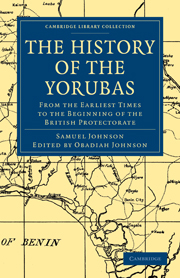Book contents
- Frontmatter
- AUTHOR'S PREFACE
- EDITOR'S PREFACE
- Contents
- 1 INTRODUCTION
- 2 THE YORUBA LANGUAGE
- 3 A SKETCH OF YORUBA GRAMMAR
- PART I THE PEOPLE, COUNTRY, AND THE LANGUAGE
- PART II
- CHAPTER I THE FOUNDERS OF THE YORUBA NATION
- CHAPTER II HISTORICAL KINGS
- CHAPTER III THE KINGS OF OYO IGBOHO
- CHAPTER IV A SUCCESSION OF DESPOTIC KINGS
- CHAPTER V BASORUN GAHA AND HIS ATROCITIES AND ABIODUN'S PEACEFUL REIGN
- CHAPTER VI THE REVOLUTION
- CHAPTER VII THE RISE OF THE FULANIS TO POWER
- CHAPTER VIII CONSEQUENCES OF THE REVOLUTION
- CHAPTER IX FURTHER DEVELOPMENT OF THE ANARCHY
- CHAPTER X SPREAD OF THE ANARCHY
- CHAPTER XI THE REVOLUTION IN THE EPO DISTRICTS
- CHAPTER XII WARS FOR THE CONSOLIDATION AND BALANCE OF POWER
- CHAPTER XIII THE LAST OF KATUNGA
- CHAPTER XIV THE INTERREGNUM
- CHAPTER XV THE NEW CITY, NEW GOVERNMENT, ILORIN CHECKED
- CHAPTER XVI FRATRICIDAL WARS
- CHAPTER XVII SUBJUGATION OF THE IJESAS AND EKITI'S SOCIAL REFORMS
- CHAPTER XVIII A GLORIOUS END AND A GORY DAWN OF TWO REIGNS
- CHAPTER XIX SEQUELS TO THE IJAYE WAR
- CHAPTER XX THE CLOSE AND THE OPENING CAREERS OF TWO HEROES
- CHAPTER XXI TWO ADMINISTRATIONS OF OPPOSITE POLICIES
- CHAPTER XXII A NEW REIGN AND EVIL PROGNOSTICATION
- CHAPTER XXIII THE COMMENCEMENT OF THE 16 YEARS' WAR
- CHAPTER XXIV CONFLICTS IN THE NORTH
- CHAPTER XXV IBADAN AT ITS EXTREMITY
- CHAPTER XXVI FAILURES AT RECONCILIATION
- CHAPTER XXVII A RIFT IN THE CLOUD
- CHAPTER XXVIII THE REV. J. B. WOOD AND THE A.O.K.
- CHAPTER XXIX THE INTERVENTION OF THE BRITISH GOVERNMENT
- CHAPTER XXX DISPERSAL OF THE COMBATANTS BY SPECIAL COMMISSIONERS
- CHAPTER XXXI DISTURBANCE IN EVERY PART OF THE COUNTRY
- CHAPTER XXXII ABORTIVE MEASURES TO TERMINATE THE WAR
- CHAPTER XXXIII THE DARK BEFORE THE DAWN
- CHAPTER XXXIV THE END OF THE WAR
- CHAPTER XXXV THE ESTABLISHMENT OF THE BRITISH PROTECTORATE. THE SEQUEL
- APPENDIX A TREATIES AND AGREEMENTS
- APPENDIX B
- INDEX
CHAPTER IV - A SUCCESSION OF DESPOTIC KINGS
Published online by Cambridge University Press: 05 July 2011
- Frontmatter
- AUTHOR'S PREFACE
- EDITOR'S PREFACE
- Contents
- 1 INTRODUCTION
- 2 THE YORUBA LANGUAGE
- 3 A SKETCH OF YORUBA GRAMMAR
- PART I THE PEOPLE, COUNTRY, AND THE LANGUAGE
- PART II
- CHAPTER I THE FOUNDERS OF THE YORUBA NATION
- CHAPTER II HISTORICAL KINGS
- CHAPTER III THE KINGS OF OYO IGBOHO
- CHAPTER IV A SUCCESSION OF DESPOTIC KINGS
- CHAPTER V BASORUN GAHA AND HIS ATROCITIES AND ABIODUN'S PEACEFUL REIGN
- CHAPTER VI THE REVOLUTION
- CHAPTER VII THE RISE OF THE FULANIS TO POWER
- CHAPTER VIII CONSEQUENCES OF THE REVOLUTION
- CHAPTER IX FURTHER DEVELOPMENT OF THE ANARCHY
- CHAPTER X SPREAD OF THE ANARCHY
- CHAPTER XI THE REVOLUTION IN THE EPO DISTRICTS
- CHAPTER XII WARS FOR THE CONSOLIDATION AND BALANCE OF POWER
- CHAPTER XIII THE LAST OF KATUNGA
- CHAPTER XIV THE INTERREGNUM
- CHAPTER XV THE NEW CITY, NEW GOVERNMENT, ILORIN CHECKED
- CHAPTER XVI FRATRICIDAL WARS
- CHAPTER XVII SUBJUGATION OF THE IJESAS AND EKITI'S SOCIAL REFORMS
- CHAPTER XVIII A GLORIOUS END AND A GORY DAWN OF TWO REIGNS
- CHAPTER XIX SEQUELS TO THE IJAYE WAR
- CHAPTER XX THE CLOSE AND THE OPENING CAREERS OF TWO HEROES
- CHAPTER XXI TWO ADMINISTRATIONS OF OPPOSITE POLICIES
- CHAPTER XXII A NEW REIGN AND EVIL PROGNOSTICATION
- CHAPTER XXIII THE COMMENCEMENT OF THE 16 YEARS' WAR
- CHAPTER XXIV CONFLICTS IN THE NORTH
- CHAPTER XXV IBADAN AT ITS EXTREMITY
- CHAPTER XXVI FAILURES AT RECONCILIATION
- CHAPTER XXVII A RIFT IN THE CLOUD
- CHAPTER XXVIII THE REV. J. B. WOOD AND THE A.O.K.
- CHAPTER XXIX THE INTERVENTION OF THE BRITISH GOVERNMENT
- CHAPTER XXX DISPERSAL OF THE COMBATANTS BY SPECIAL COMMISSIONERS
- CHAPTER XXXI DISTURBANCE IN EVERY PART OF THE COUNTRY
- CHAPTER XXXII ABORTIVE MEASURES TO TERMINATE THE WAR
- CHAPTER XXXIII THE DARK BEFORE THE DAWN
- CHAPTER XXXIV THE END OF THE WAR
- CHAPTER XXXV THE ESTABLISHMENT OF THE BRITISH PROTECTORATE. THE SEQUEL
- APPENDIX A TREATIES AND AGREEMENTS
- APPENDIX B
- INDEX
Summary
OBALOKUN AGANA ERIN
Obalokun succeeded to the throne of his fathers. His mother was the daughter of the Alake, the Primus of the Egba chiefs.
The most memorable event of this reign was the introduction of salt into the Yoruba country. The article hitherto used for it was an insipid rock salt known as Obu. Salt now known as iyo was at first called dùn-mómó.
This King was said to be in friendly relations with the King of France (probably Portugal) with whom he had direct communication. It was said that the King sent 800 messengers with presents to that European sovereign, but that they were never heard of again. Tradition says that the sounds of bells ringing in the skies was plainly heard in the Akesan (King's) market, and it was conjectured that it was the voices of the unfortunates speaking to them from the other world to tell their fate.
What natural phenomenon this may have been due to which was interpreted thus, we do not know, but so it was believed at the time, and similar omens are not unknown to history.
It was said that a white traveller visited Oyo during this reign.
This King placed the first Ajele (political resident) at Ijãna near Ilaro, with the title of Onisãrè. The appointment of an Onisãrè was regularly from Oyo and he must be a Tapà by birth.
- Type
- Chapter
- Information
- The History of the YorubasFrom the Earliest Times to the Beginning of the British Protectorate, pp. 168 - 177Publisher: Cambridge University PressPrint publication year: 2010First published in: 1921



